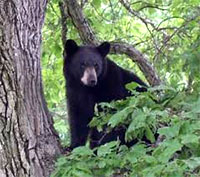 When considering a visit to the Ridenour Swamp Wildlife Management Area (WMA) think of cool mountain forests, clear running streams and abundant wildlife. This small WMA, at 82 acres , is located in the Catoctin Mountains of northwestern Frederick County. Ridenour Swamp WMA provides protection to the large wetland complex located on the area. The property affords protection to the headwaters of Middle Creek, an important tributary to Catoctin Creek. This wildlife management area provides important habitat to a number of forest wildlife species, but also harbors a number of rare, threatened or endangered plant species.
When considering a visit to the Ridenour Swamp Wildlife Management Area (WMA) think of cool mountain forests, clear running streams and abundant wildlife. This small WMA, at 82 acres , is located in the Catoctin Mountains of northwestern Frederick County. Ridenour Swamp WMA provides protection to the large wetland complex located on the area. The property affords protection to the headwaters of Middle Creek, an important tributary to Catoctin Creek. This wildlife management area provides important habitat to a number of forest wildlife species, but also harbors a number of rare, threatened or endangered plant species.
What to See
 With a diversity of forest cover and old field habitat this particular WMA packs a punch on wildlife richness. The extensive Oak/poplar forest provides ideal habitat for many forest dwelling wildlife species. White-tailed deer, wild turkey and black bear are some of forest wildlife species that can be found on the property. For the birding enthusiast the opportunity to see many forest interior birds during their spring migration awaits you. During the warmer months, woodland flowers can be seen throughout the WMA. Extensive patched of Skunk cabbage maybe found throughout the swamp during the early spring season. Skunk cabbage is an important early spring food source for black bears as they emerge from their winter dens.
With a diversity of forest cover and old field habitat this particular WMA packs a punch on wildlife richness. The extensive Oak/poplar forest provides ideal habitat for many forest dwelling wildlife species. White-tailed deer, wild turkey and black bear are some of forest wildlife species that can be found on the property. For the birding enthusiast the opportunity to see many forest interior birds during their spring migration awaits you. During the warmer months, woodland flowers can be seen throughout the WMA. Extensive patched of Skunk cabbage maybe found throughout the swamp during the early spring season. Skunk cabbage is an important early spring food source for black bears as they emerge from their winter dens.
What to do
 For the dedicated archery hunter, this archery hunting only area offers a respite for the everyday doldrums of urban life. White-tailed deer, wild turkey and grey squirrel abound on the property, offering a challenging opportunity. For the non-hunter, this wooded property offers many opportunities to photograph colorful woodland flowers and birds. In the early spring the opportunity to collect wild moral mushrooms is a popular activity on the area.
For the dedicated archery hunter, this archery hunting only area offers a respite for the everyday doldrums of urban life. White-tailed deer, wild turkey and grey squirrel abound on the property, offering a challenging opportunity. For the non-hunter, this wooded property offers many opportunities to photograph colorful woodland flowers and birds. In the early spring the opportunity to collect wild moral mushrooms is a popular activity on the area.
Area Regulations
- Use of Ridenour Swamp WMA is generally permitted seven days a week throughout the year.
- Hunting is allowed in accordance with established seasons and hunting hours.
- Due to its small size, only archery hunting is allowed on the WMA.
- Trapping is not permitted.
- Disabled hunters may use the property by parking in several scattered pull-offs located along Ridenour Rd.
Special Areas
- Ridenour Swamp WMA is managed to provide important habitat for forest wildlife species.
- The area offers protection to the unique wetland area located on the site, which supports a number of rare plant species.
Non-Hunting User Guide
- Non-hunting visitors are welcome on the WMA.
- Be aware of open hunting seasons and visit accordingly.
- Bird watching, nature photography and mushroom hunting are popular uses of the area.
- Hardwood forest, wetlands and several old fields compose all of the property and support a rich variety of songbirds and wildflower species.
- The area is relatively flat, which offers an easy stroll through the property.
Site Management Goals
The primary management goal of this wildlife area is to provide protection to this unique wetland and the number of rare, threatened and endanger plant species that the wetland harbors.
Directions:
From Interstate 70 west bound, take the Myersville exit (exit # 42) and proceed north on Rt. 17 until you come to the town of Wolfsville. Then turn right on to Stottlemeyer and continue for approximately 4 miles and make a left on to Ridenour Rd. Continue on Ridenour Rd for approximately 1 mile. The WMA will be on both sides of Ridenour Rd.
 Click Here for Map
Click Here for Map